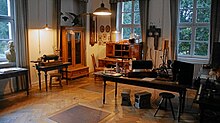X-ray memorial
The Röntgen Memorial in Würzburg honors the work of the German physicist Wilhelm Conrad Röntgen (1845–1923) and his achievement of the discovery of X-rays, which was honored with the first Nobel Prize in Physics, with an exhibition of historical instruments and apparatus as well as original documents.
location
The Röntgen Memorial is located in the corridors and two laboratory rooms on the first floor of the former Physics Institute of the University of Würzburg at Röntgenring 8, in a building that is now used by the University of Applied Sciences Würzburg-Schweinfurt . In 1909 the former “Pleicherring”, on which the house is located, was renamed “Röntgenring” in honor of Röntgen.
history
On the late Friday evening of November 8th, 1895 , Röntgen discovered in his laboratory, in his own words, "when there were no more submissive spirits in the house", the rays penetrating matter, which he called X-rays . He presented his work on a new kind of rays on January 23, 1896 at a lecture given by the Physico-Medical Society in Würzburg:
"If you let the discharges of a larger Rühmkorff pass through a Hittorf vacuum tube or a sufficiently evacuated Lenard , Crookes or similar apparatus and cover the tube with a fairly tight-fitting jacket made of thin, black cardboard, you can see one in the completely darkened room The paper screen painted with barium platinum cyanide, which is brought near the apparatus, lights up brightly with every discharge and fluoresces , regardless of whether the painted or the other side of the screen is facing the discharge apparatus. The fluorescence is still noticeable at a distance of 2 m from the device. "
On this occasion, the anatomist Albert von Kölliker suggested naming the rays after the person who discovered them: X-rays .
Exhibits
The Röntgen Memorial gives an insight into the experimental physics of the late 19th century and shows, in addition to the discovery apparatus, the structure of a cathode ray experiment , which was the basis of Röntgen’s discovery, as well as a fluoroscopic experiment with X-rays and the historical Röntgen laboratory. Various X-ray tubes , a medical X-ray machine from Siemens & Halske from 1912 and several original documents are on display in another exhibition room . At the entrance, a film presents an outline of the memorial and Röntgen's work. Some of Röntgen's personal items are on display in the corridor to shed light on his personal and historical surroundings at the time of his discovery.
For the 120th anniversary in 2015, the exhibition concept was modernized.
Board of Trustees
The non-profit association Kuratorium for the promotion of the memory of Wilhelm Conrad Röntgen in Würzburg eV (short: Röntgen-Kuratorium Würzburg eV ) has been promoting the memory of Wilhelm Conrad Röntgen at the place of his discovery of the X-rays by designing, maintaining and looking after the X-rays since December 1982 -Memorial site. The Röntgen Memorial opened on November 7, 1985.
Web links
- Website of the Roentgen Memorial Würzburg
- X-ray Memorial Würzburg . In: Museen-in-Bayern.de
- 120 years of "X-rays" - the X-ray memorial shines in new splendor . In: DRG.de
Individual evidence
- ↑ WCRöntgen: About a new kind of rays emphasis Severus Verlag , Hamburg 2012, ISBN 978-3-86347-345-7
- ↑ http://www.roro-seiten.de/physik/roentgen/entdeck1.html
- ↑ The Roentgen Memorial.
- ↑ Eckart Roloff and Karin Henke-Wendt: This is where transparent people were born. (The X-ray memorial in Würzburg) In: Visit your doctor or pharmacist. A tour through Germany's museums for medicine and pharmacy. Volume 2, Southern Germany. Verlag S. Hirzel, Stuttgart 2015, pp. 158-160, ISBN 978-3-7776-2511-9 .
Coordinates: 49 ° 48 ′ 0 ″ N , 9 ° 55 ′ 51.2 ″ E







